By Kingfisher Visitor Guides
It's time to brush up on your knowledge of the UK's most impressive football stadiums – here's 17 of the best.
Wembley Stadium
Wembley Stadium opened in 2007, on the site of the original Wembley Stadium (where England won the 1966 World Cup!), which was demolished from 2002-2003. The stadium hosts major football matches including home matches of the England national football team, and the FA Cup semi-finals and finals as well as other major sports and music events.
Location: London
Home to: England national team
Capacity: 90,000
Opened: 2007
Getting there: Wembley Park tube station on the Metropolitan and Jubilee lines
Other notable events: NFL American football, rugby league’s Coral Challenge Cup Final, EFL Play-offs, various music concerts
Pubs nearby: Flannery’s Bar, JJ Moon’s
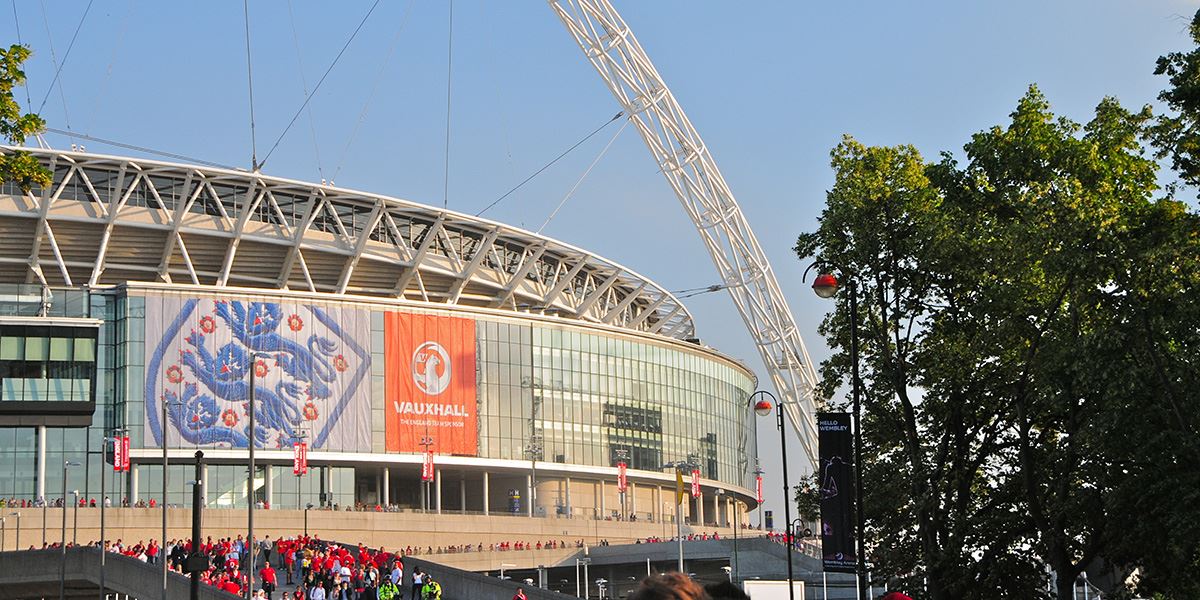
Wembley Stadium, London
Read more about London
Celtic Park
Celtic formed in 1887 and the first Celtic Park opened in Parkhead in 1888. The club moved to the current site in 1892, the stadium was initially oval-shaped with a cycling track, pavilion, and one wooden stand at the Janefield Street side. With 46 Scottish Championships and 36 Scottish Cups in their trophy cabinet, it’s fair to say that Celtic FC is a club synonymous with Scottish football.
Location: Glasgow
Home to: Celtic FC
Capacity: 60,832
Opened: 1888
Getting there: Buses 61, 62 from Glasgow Central rail station, train to Dalmarnock or Bridgeton rail stations followed by a 15-minute walk
Other notable events: Heineken Cup, European Rugby Challenge Cup, Rugby World Cup
Pubs nearby: Hoops Bar, Kerrydale Bar, Waxy O’Connor’s

Celtic Park, Glasgow
Read more about Glasgow
St James’ Park
St James’ connection with ‘the beautiful game’ precedes the birth of the club, with the first organised practice match on the site recorded as taking place in 1880 – a full 12 years before the official formation of Newcastle United. In 1892 the first official match as Newcastle United FC was played, and the rest is history. St James’ Park is now one of the greatest arenas of world football, also hosting many international sporting events such as the Rugby World Cup 2016 and the European Champions Cup Final 2019.
Location: Newcastle upon Tyne
Home to: Newcastle United FC
Capacity: 52,405
Opened: 1892
Getting there: St James’ Park Metro stop
Other notable events: Heineken Cup, European Rugby Challenge Cup, Rugby World Cup
Pubs nearby: Nine Bar, Shark Club, The Strawberry
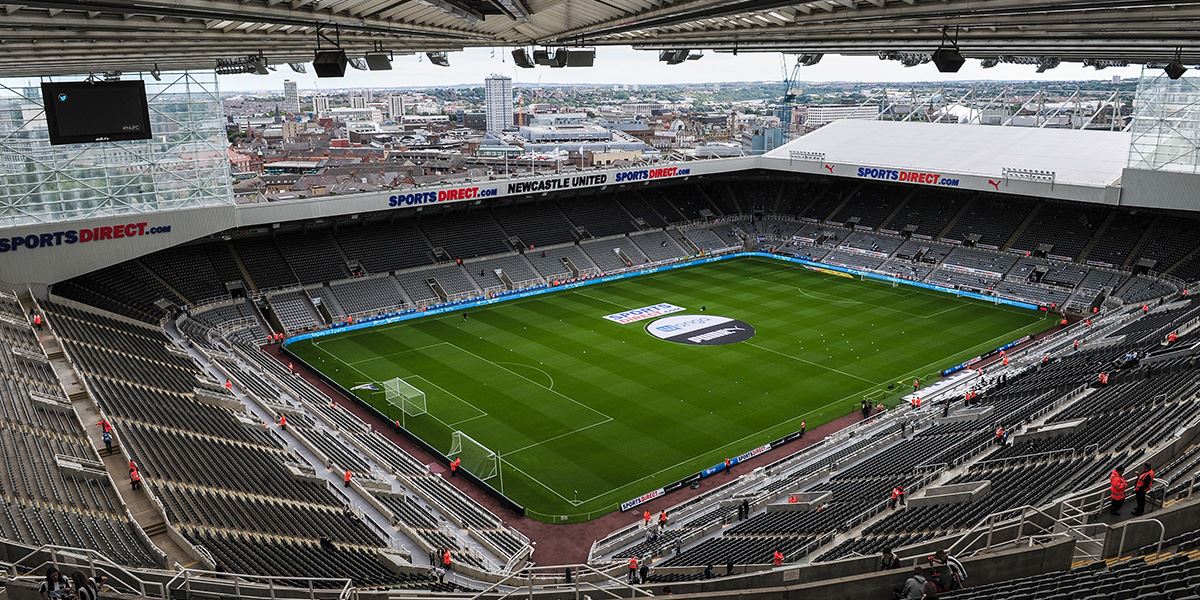
St James’ Park, Newcastle
Read more about Newcastle and Gateshead
Principality Stadium
Since opening in June 1999, the Principality Stadium (formerly known as the Millennium Stadium until 2016) has welcomed, on average, over 1.3 million visitors per year. Sporting the first fully-retractable roof in the UK, the venue is at the cutting edge as a multi-purpose and adaptable event venue. The stadium boasts a UEFA five-star rating and has hosted matches from two Rugby World Cups including the Final in 1999, witnessed three Wales Grand Slam successes in the RBS Six Nations and staged six showpiece FA Cup Finals.
Location: Cardiff
Home to: Wales national football team
Capacity: 74,500
Opened: 1999
Getting there: Cardiff Central is the nearest station to the stadium and operates mainline services from West Wales, the Midlands, the South Coast and London.
Other notable events: International Champions Cup, Rugby Union League, Nitro World Games, Rugby World Cup
Pubs nearby: Queens Vaults, The Gatekeeper, City Arms
Read more about Cardiff and the Vale of Glamorgan
Old Trafford
Bombed during the Second World War, Old Trafford recovered considerably, adopting various guises before morphing into the 75,635-seater home of the Premier League’s most-successful team. For those who want to delve into the inner workings of Europe’s leading club, you can soak up the majesty of the stadium with a tour and museum visit, but it’s on match days when Old Trafford comes to life, roared on by a 75,000-capacity crowd.
Location: Manchester
Home to: Manchester United FC
Capacity: 75,811
Opened: 1910
Getting there: Train via Manchester Piccadilly Station, Metrolink tram to Old Trafford station approximately a 10-minutes walk away
Other notable events: Betfred Super League Grand Final, Ashes Test matches
Pubs nearby: Matchstick Man, The Dockyard, The Bishop Blaize
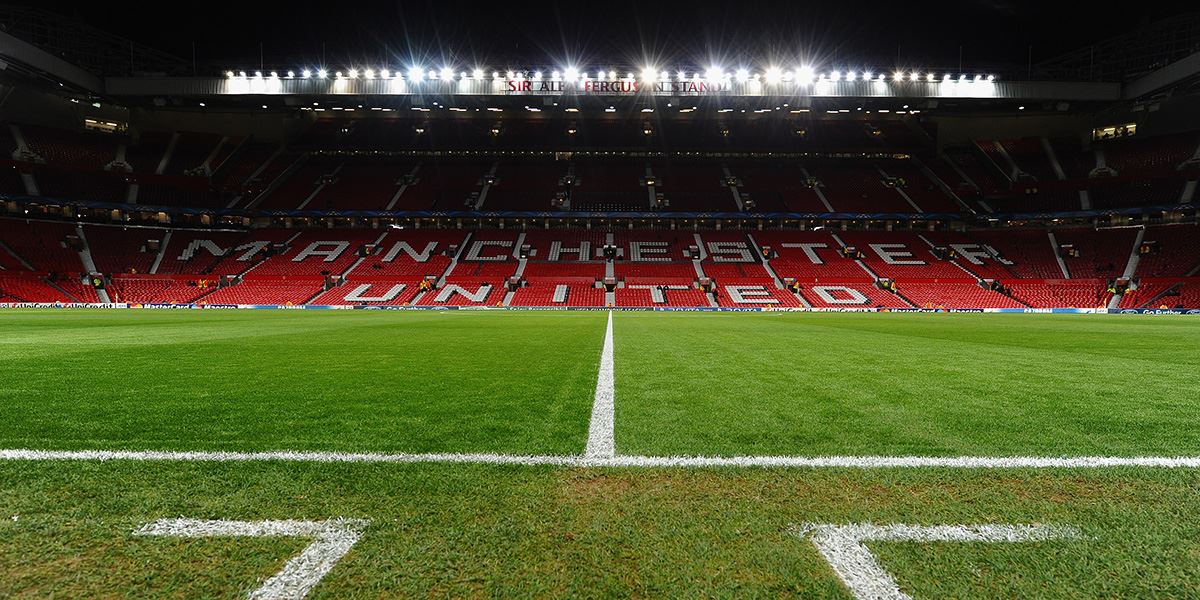
Old Trafford, Manchester
Read more about Manchester
Stadium of Light
The Stadium of Light was built in the mid 1990s to replace Sunderland’s old stadium, Roker Park, which could not be expanded or modernised. The stadium was named by chairman Bob Murray to reflect the coal mining heritage of the North East and the former Monkwearmouth Colliery site on which it stands.
Location: Sunderland
Home to: Sunderland FC
Capacity: 49,000
Opened: 1997
Getting there: Take the Metro direct to the Stadium of Light or St Peter’s Metro stops
Other notable events: UEFA Euro 2004, Beyoncé’s Formation World Tour 2016, Spice Girls Spice World Tour 2019
Pubs nearby: Colliery Tavern, The Cambridge, The Wolsey
Emirates Stadium
Although Highbury was one of the most famous football stadiums in the world, Arsenal realised that in order to be able to compete with the elite clubs in Europe they needed to design a larger stadium to increase capacity and revenue. Enter the award-winning Emirates Stadium. Today, Arsenal continues their legacy of 13 League titles, a record 13 FA Cups, 2 League Cups, 15 FA Community Shields, 1 League Centenary Trophy, 1 UEFA Cup Winners’ Cup and 1 Inter-Cities in this outstanding stadium.
Location: London
Home to: Arsenal FC
Capacity: 60,260
Opened: 2006
Getting there: Arsenal (Piccadilly Line) is the nearest tube station, around three minutes’ walk from the ground. Finsbury Park (Victoria, Piccadilly Lines and Great Northern Rail) and Highbury & Islington (Victoria Line, North London Line and Great Northern Rail) stations are around a 10-minute walk – these should be slightly less crowded
Pubs nearby: Tollington Arms, The Old Crown Public House, The Gunners
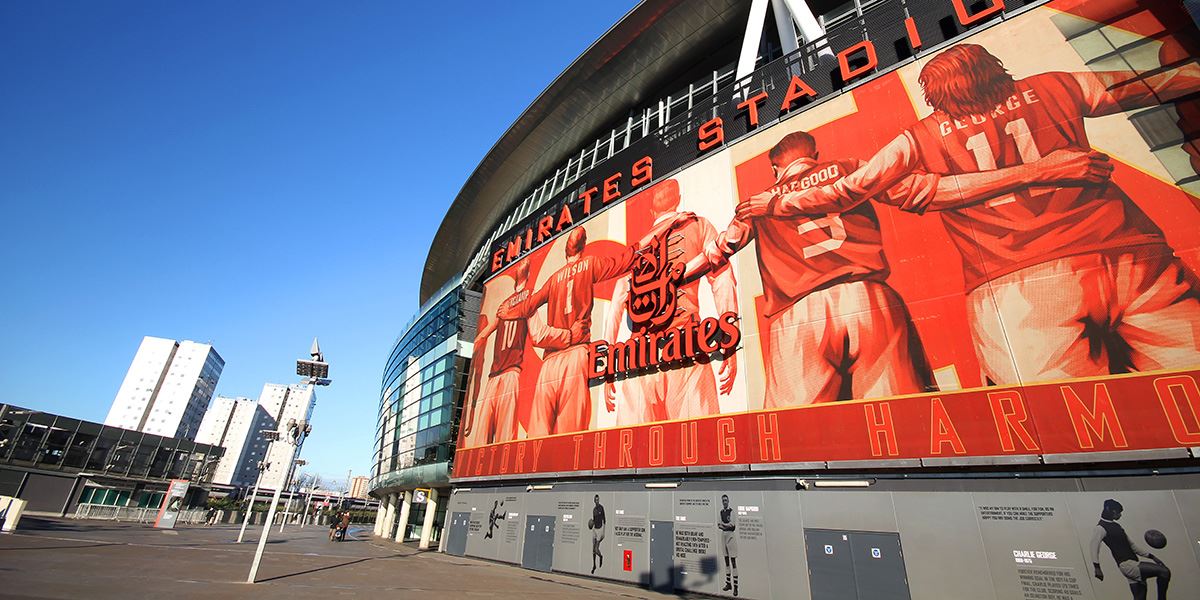
Emirates Stadium, London
Read more about London
Riverside Stadium
The gates of the Riverside Stadium opened for business on August 25 1995 when Boro took on Chelsea in the opening weekend in Premier League history. Craig Hignett scored the first goal at the new ground after 39 minutes, a 2-0 victory assured when Jan Aage Fjortoft added a second in the 76th minute.
Location: Middlesbrough
Home to: Middlesbrough FC
Capacity: 34,742
Opened: 1995
Getting there: Middlesbrough Railway Station is located on Albert Road which is a 10 to 15 minutes’ walk from the Riverside Stadium
Other notable events: National Premier League, Take That 2019
Pubs nearby: The Six Medals, The Nuthatch, The Isaac Wilson
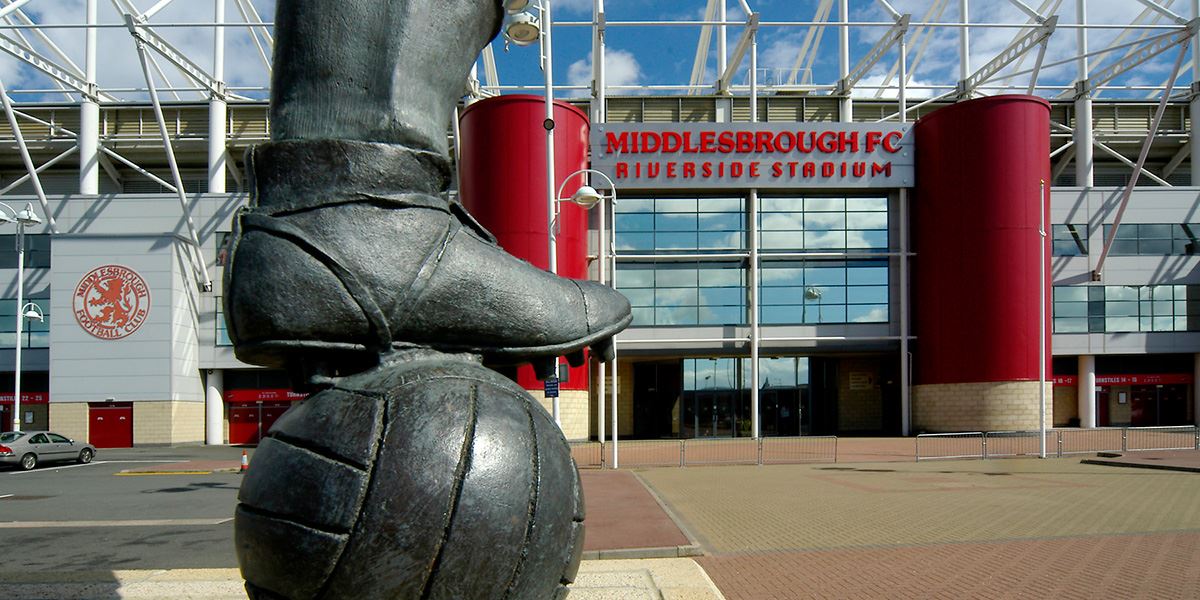
Riverside Stadium, Middlesbrough
Read more about Durham and Tees Valley
Tottenham Hotspur Stadium
After an emotional farewell to White Hart Lane at the end of the 2016/17 season, Tottenham Hotspur will now play their home games in this stadium. Spurs celebrated the opening of their new home on 3rd April 2019. Capacity at this brand new venue is 62,062 with nine floors and only five metres from the first line of seats to the goal.
Location: London
Home to: Tottenham Hotspur FC
Capacity: 62,062
Opened: 2019
Getting there: Travel by bus to the venue, with four stations and up to 144 buses an hour serving the stadium area or take the overground to White Hart Lane
Pubs nearby: The Bricklayers, The Blue Bar, The Antwerp Arms
Read more about London
Anfield
Anfield was built in 1884, but got initially rented by Everton FC. In 1891 the newly-founded Liverpool moved into the grounds. Anfield underwent developments in the late 19th and early 20th century, including the construction of a new main stand designed by Archibal Leitch in 1895 and a decade later the construction of the famous Spion Kop.
Location: Liverpool
Home to: Liverpool FC
Capacity: 54,074
Opened: 1884
Getting there: Bus via Liverpool City Centre, take the 26 from Liverpool ONE bus station, 17 from Queen Square Bus Station or the 917 from St Johns Lane, directly to the ground
Other notable events: Euro 1996, P!NK – Beautiful Trauma World Tour 2019
Pubs nearby: The Park, Oakfield Pub, The Albert Pub
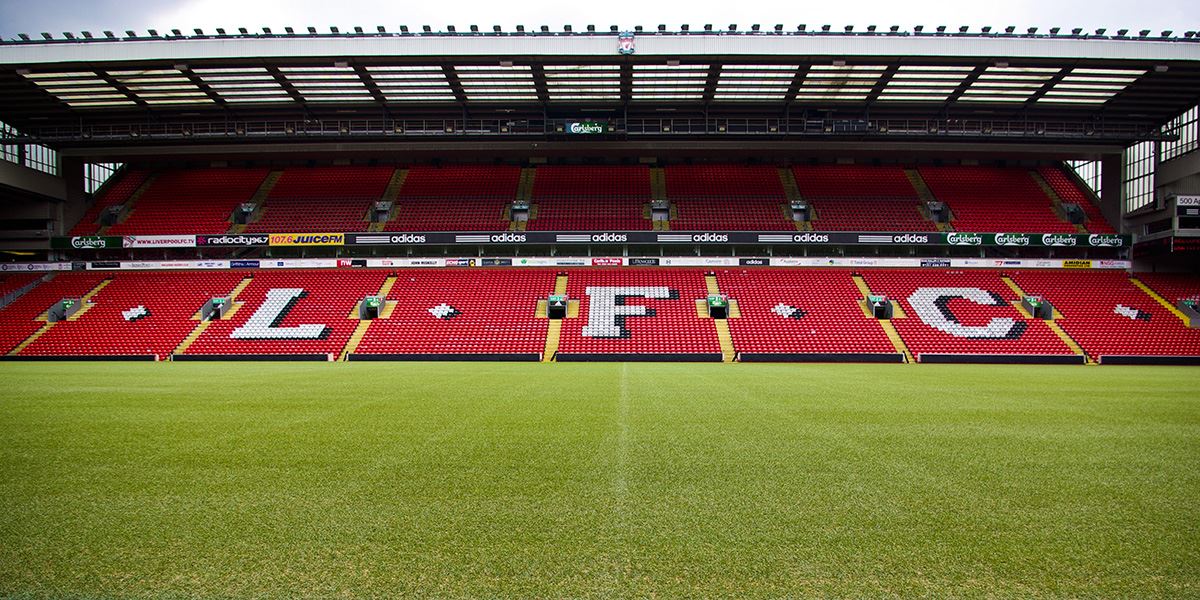
Anfield, Liverpool
Read more about Liverpool
Etihad Stadium
The Etihad Stadium, also known as Eastlands, was originally built for the 2002 Commonwealth Games. After the games, the stadium was converted into a football stadium to provide Manchester City with a modern replacement for their former home at Maine Road and they moved in at the start of the 2003-2004 season. Now expanded to a capacity of over 55,000 it has become one of the best stadiums in the country, not only in terms of size but also in its outstanding facilities.
Location: Manchester
Home to: Manchester City FC
Capacity: 55,097
Opened: 2002
Getting there: Metrolink, a dedicated tram stop, Etihad Campus is adjacent to the stadium, located in City Square
Other notable events: Metallica 2019, Muse 2019, Spice Girls Spice World Tour 2019
Pubs nearby: Mary D’s Beamish Bar, Grove Inn, The Townley

Etihad Stadium, Manchester
Read more about Manchester
Villa Park
In the late 19th century, what is now Villa Park was part of a pleasure ground that consisted of a football and cricket pitch, athletics track and a small grandstand. At the time Aston Villa played at the Perry Barr ground, until 1897 when they moved to the bigger and better Villa Park in 1897. Villa Park remains their home to this day, although it has undergone various changes and developments over the years.
Location: Birmingham
Home to: Aston Villa FC
Capacity: 42,785
Opened: 1897
Getting there: The two nearest train stations to Villa Park are Witton and Aston
Other notable events: The Big Villa Sleep Out
Pubs nearby: The Holte, The Aston Tavern, The Bartons Arms

Villa Park, Birmingham
Read more about Birmingham and the Black Country
King Power Stadium
In August 2002, Leicester City FC moved into its new home, only a short distance away from their old Filbert Street ground. Previously called the Walkers Stadium, it was renamed the King Power Stadium in 2011. It has four stands that each join in an enclosed design. The away supporters are situated in the corner between the North and East stand.
Location: Leicester
Home to: Leicester City FC
Capacity: 32,312
Opened: 2002
Getting there: Leicester train station is approximately 1.2 miles from King Power Stadium, which is roughly a five-minute car journey or a 20-minute walk
Other notable events: Rugby League
Pubs nearby: Blues Bar & Grill, Local Hero, Counting House
Read more about Leicestershire
London Stadium
London Stadium is a multi-purpose outdoor stadium at Queen Elizabeth Olympic Park in the Stratford district of London. It was constructed for the 2012 Summer Olympics and 2012 Summer Paralympics, designed as the track and field venue, and as the site of their spectacular opening and closing ceremonies.
Where: London
Home to: West Ham United FC
Capacity: 66,000
Opened: 2008
Getting there: Travel via tube to Stratford station followed by a 20-minute walk
Other notable events: 2012 London Olympics
Pubs nearby: The Cow, Howling Hops Brewery, Tap East

London Stadium, London
Read more about London
Hillsborough Stadium
Sheffield Wednesday took up residence at the Hillsborough Stadium in 1899. The stadium was the scene of a stadium disaster that cost the lives of 96 Liverpool fans. Known as the Hillsborough disaster, the fans were involved in a fatal crush resulting in 96 fatalities and 766 injuries.
Where: Sheffield
Home to: Sheffield Wednesday FC
Capacity: 39,732
Opened: 1899
Getting there: The two nearest train stations to Villa Park are Witton and Aston
Other notable events: The Big Villa Sleep Out
Pubs nearby: The Hillsborough Tap, Old Crown Inn, The Rawson Spring

Sheffield Wednesday fans at Hillsborough
Read more about South Yorkshire
Ibrox Park
The Ibrox Stadium is located on the south side of the River Clyde, in the Ibrox district of Glasgow. Home to Rangers FC, it’s the third largest football stadium in Scotland. Ibrox was initially oval-shaped, had a track circling the pitch, and mainly consisted of wooden scaffold type terraces. The first match played at the stadium was a match against Hearts on the 30 December 1899.
Location: Glasgow
Home to: Rangers FC
Capacity: 51,082
Opened: 1899
Getting there: The circular Glasgow subway system links Ibrox with the city centre. Board the metro in the centre, e.g. at Buchanan Street or St Enoch, and get off at Ibrox station.
Other notable events: EUFA Euro 2016, Scottish Cup Final 1997, Frank Sinatra 1990, Elton John and Billy Joel 1998
Pubs nearby: Louden Tavern Ibrox, Park Bar, District Bar

Ibrox Stadium, Glasgow
Read more about Glasgow
St Mary’s Stadium
St Mary’s Stadium in Southampton has been the home stadium of Premier League club, Southampton FC since 2001. The stadium has a capacity of 32,505 and is currently the largest football stadium in South East England.
Location: Southampton
Home to: Southampton FC
Capacity: 32,505
Opened: 2000
Getting there: Southampton is served by Southampton Central railway station, which is approximately a mile from the stadium – roughly a 20-minute walk
Other notable events: Rugby League
Pubs nearby: The Chapel Inn, The Joiners, Kingsland Tavern
Read more about Hampshire and the Isle of Wight









